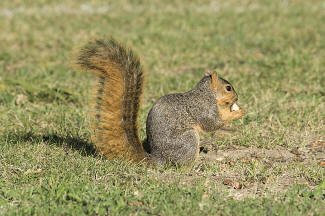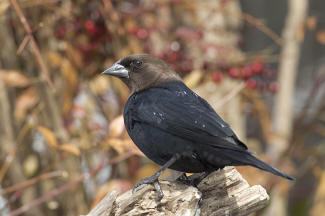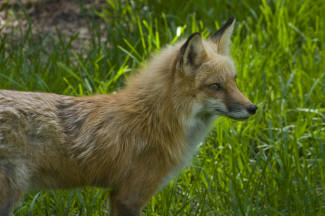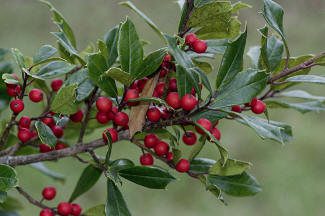PROFILES IN NATURE
Fox Squirrel
Photo Credit – www.kentuckyupclose.com
With regular gun deer season over and duck and goose season just getting
a good start, a lot of folks are hitting the woods in search of small game.
The Fox Squirrel, Sciurus
niger, is the largest of the tree dwelling squirrels in North
America and is common over most of the Eastern United States.
Seeming to prefer open wooded areas with little or no undergrowth
the fox squirrel spends considerable time on the ground away from trees,
more so than the gray squirrel. This makes large areas of Ballard County
attractive to this squirrels habitat requirements.
Fox squirrels build two types of nest. Multiple leaf nest may be
constructed and are used year round. Dens in hollow trees are cleaned
out and utilized for rearing of young and more inclement weather.
Normally two liters are raised each year, one in very early
spring and another around mid-summer. The number of offspring is
normally between two and four.
All squirrels are rodents just like rats and mice. This means
that they have upper and lower incisors that grow continuously and must
be kept short by gnawing. Feeding on a variety of nuts, berries, bark,
tree buds, and unfortunately, mature corn crops and bird feeder contents
keep these teeth worn down. Fox squirrels eat a variety of other food
including insects, bird eggs, acorns, hickory nuts, pecans, walnuts, and
other tree seeds.
Locally our squirrels are yellowish brown with orange color on
their belly. In other regions though, they can be black or a combination
of black and brown with white facial markings.
Weighing in at one to two pounds makes these squirrels
worth-while game animals. Many a youngster in Western Kentucky got their
first experience of hunting by pursuing fox and gray squirrels.
By Jack
Glisson
Published in The Ballard County Weekly 12/03/2014
PROFILES IN NATURE
Brown-headed Cowbird
Photo Credit – www.kentuckyupclose.com
Often seen in large numbers flying with grackles, blackbirds,
starlings, and red-winged blackbirds is the Brown-headed Cowbird or
Molothrus ater. Living in
this area year round their numbers may increase in winter as some of the
more northern residents migrate south.
Their common name derives from the fact that the bird has adapted
to following herds of cattle around so as to feed on the insects stirred
up from the larger animals. Historically they did the same thing with
bison.
Pictured here is the male. Females are slightly smaller with a
grayish base color and fine brown markings that are lighter on the
throat and underparts.
Although insect eaters in summer their beak is well adapted to
feed on a variety of seeds when insects are not available.
Cowbirds do not build a nest of their own. Instead, they will
watch other small birds nest and when egg laying starts will secretively
lay eggs in the other birds nest. This behavior probably evolved due the
habit of following herd animals and not being able to spend extended
nesting times in one area. Sometimes the parasitized bird will recognize
the strange egg and throw it out, build over it, or just abandon the
nest. Many times however the cowbird is raised by the host parent. This
is often detrimental to the host as many times the cowbird is larger and
may push the other young birds out of the nest. Cowbirds may lay up to
forty eggs in a single season.
By Jack
Glisson
Published in The Ballard County Weekly 12/10/2014
PROFILES IN NATURE
Red Fox
We have two species of fox in this area but by far the most
common is the Red Fox, or Vulpes
vulpes. The other one is the gray fox.
Reds are much larger than grays weighing in at anywhere from six
to over twenty pounds.
Red foxes are capable hunters. Normally feeding on a variety of
small animals such as squirrels, rabbits, mice and rats, they will even
eat such things as frogs and insects. With their acute hearing mice can
be located under several inches of snow or grass, the fox will stand on
his rear legs and then pounce pinning the hapless mouse using his front
paws.
Foxes mate during the winter months and give birth to pups in
early spring. Usually a den tunnel is dug prior to birthing. Young can
number anywhere from two to twelve but around four seems common. The
pups are a brownish or grey color until they are around a month old and
then start growing their distinctive red hair. The pups will remain in
the area of the den for several months while both parents bring game to
feed them. This is when the dens are most noticeable with bits of hair,
bone, and feathers scattered about and sometimes quite an odor is
present from rotting food bits that didn’t get eaten. Standing on the
earth mound near the den entrance or just playing in the general area
fox pups are quick to dive back into the hole at the first sign of
danger.
By Jack
Glisson
Published in The Ballard County Weekly 12/17/2014
PROFILES IN NATURE
American Holly
Photo Credit – www.kentuckyupclose.com
The American Holly, or
Ilex opaca, has long been used as a decoration for Christmas. The
shiny green leaves and bright red berries adorn everything from
Christmas cards to wrapping paper, wreaths to hang on doors and sprays
to place on tables.
Being an evergreen, leaves are not shed annually but remain on
the tree until they are two to three years old and are then pushed off
the stem by emerging buds.
Common across the Southeast United States, holly trees are not
really native to West Kentucky. Their natural range extends into
Tennessee and Eastern Kentucky. They do well here however and many are
planted as ornamentals.
All holly trees are dioecious, which means there are male and
female trees. Only the female trees have the distinctive red berries.
Many cultivars have been developed though to be sold as nursery stock.
Some of these are all female so when planting you can make choices
between red berries or just foliage.
Although eaten by birds, the red berries are poisonous to humans.
I have found mention that as few as twenty berries can be fatal to a
child.
I hope the Holidays find everyone well and I look forward to
continuing this column next year!
By Jack
Glisson
Published in The Ballard County Weekly 12/24/2014



